
The set for Game of Thrones’ Castle Black, the stronghold at the foot of an imaginary 700-foot ice wall that the characters in the show see as the gateway between civilization and barbarity, nestles in the side of a disused quarry about a half hour from Belfast, Northern Ireland. Wander along the raised balconies of Castle Black itself and you’ll see some of the spit-and-sawdust rooms — they’re real rooms, cold, suitably Spartan. This is where we’ve watched Jon Snow and his Night’s Watch men ponder their fate in the face of the wildling threat and the more menacing spectre of the White Walkers. There are clouds of midges, the air is heavy and there’s just the faintest whiff of mildew and must and men. It’s Eau de Thrones, the smell of the biggest show on earth.
“I think I’m immune to it now,” says Kit Harington, who plays Jon Snow. “But when it rains the cloaks smell like dog, wet dog. And I think I still wear exactly the same costume I’ve always worn since halfway through season one. As much as they can wash it, it stinks — but that’s great, that’s why it does what it’s meant to — the cloak has got years of s–t on it now. It’s falling to bits as well – but it feels real.”
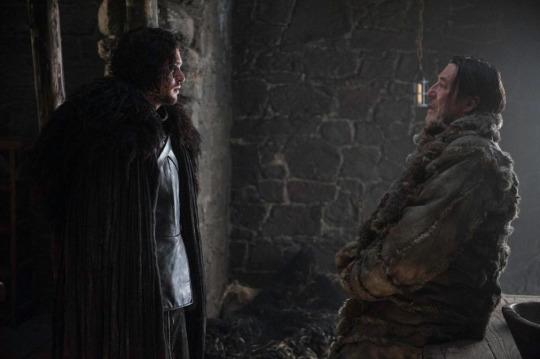
It might seem strange to talk about realism in a show that is an ardent fantasy, but if you go round the various Game of Thrones sets, costume departments and prop makers that are all based in Northern Ireland, the impression you get is that the aim of the game is to make the evidently unreal as real as possible. It’s one reason the show has been such a success — both the viewers (and the actors, to an extent) have been lured through a series of brilliant contrivances in to thinking that somehow, somewhere, this world exists.
Of course it’s not all a contrivance: The winch elevator is functional — it’s basically a repurposed industrial building site lift that travels up and down the scarp. The cliff, meanwhile, has been painted white to better resemble the ice wall. That’s right: if an entire climate and landscape isn’t right in Game of Thrones, they make it right. Later I speak to Liam Cunningham, who plays Davos Seaworth and has, by his own admission, been on a fair few big budget film sets.
“In one of the scenes which is I am going to be in this season, they had a team of painters for a month painting the landscape. Hundreds of meters of hill, all painted — because they had the terrain but they didn’t have the snow. For the snow itself they came up with these things like peat moss. You can actually make snowballs out of it; it’s ridiculous, but it’s huge money, and they’re just throwing this thing around for the texture. It looked like it had been snowing. I’ve never seen anything like that.” They could just have shoved up a huge green screen and put the snow in with CGI, says Cunningham, but that’s not how Game of Thrones operates: “They try and keep things as practical as possible, and they only use CG images when they absolutely have to.”
It starts with the small stuff — Jon Snow’s stinky pelts; the fact that every single one of the 5,000 extras has his or her costume fitted, not just flung at them from a rack; the leaves of the weirwood trees, all hand painted and coated with a velvety red flock; the precise concoction used to make sure that the snow you see on the top of the Wall has just the right crunch (it’s molten beeswax on top of polystyrene blocks with sea salt thrown at it, if you’re thinking of upgrading the Christmas display in your yard next December).
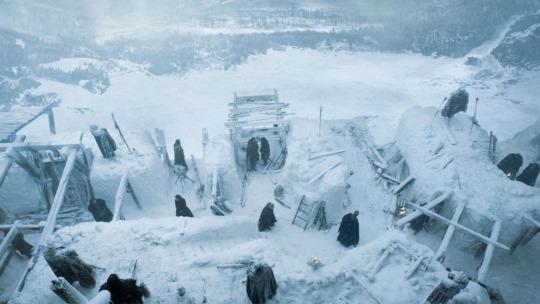
Nowhere is this fervid attention to detail more obvious than in the Armory, a warehouse that sits between the two vast soundstages in Belfast’s Titanic Quarter that make up Thrones HQ. More than 10,000 weapons have been made from scratch for the show and this is where they’re kept. If pattern-welded steel floats your boat, welcome to Valhalla. Here they have two full time blacksmiths forging metal and if you ask them they’ll proudly show you their wares — like the curlicued castration knife that did for Reek’s privates (“I was told to make it as unpleasant as possible,” says blacksmith Stephen Murphy, who succeeded). Or the three versions of Arya Stark’s signature sword Needle, one of steel, beautiful for the camera; one from lighter aluminum for the fight scenes; and one where the blade retracts in to the handle – that’s for the kill shots.
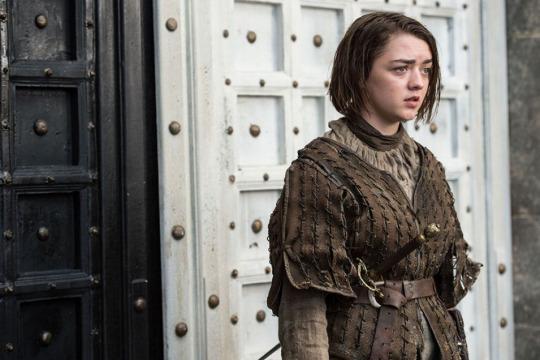
The man in charge, who has the world’s best job title of Weapons Master, is Tommy Dunne. “Anywhere you see a weapon of any shape or form it’s designed and made in house in this workshop,” he says. “We’re in a world that we want to keep authentic. We don’t want to use items from other shows so that somebody goes, ‘Oh, I know that sword, that’s off Gladiator.’ Everything is made specifically for Game of Thrones.” Dunne is a stickler that the weapons should work, first and foremost, as weapons. “All the weapons that are made are practical,” he says. “Every weapon that I make is made to the best possible standard that it can possibly be made. We don’t skimp. If something looks bad, it’s for a reason.”
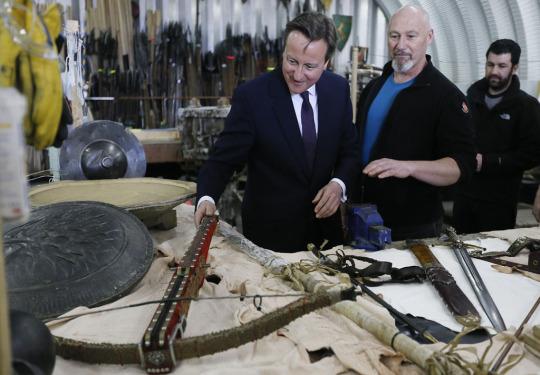
Prime Minister David Cameron (left) examines the Game of Thrones weapons room with Tommy Dunne (right)
In one corner of the Armory sits the crossbow that did for Tywin Lannister as he sat on the privy at the end of last series. “It’s fully functional,” notes Stephen Murphy. Of course it is.
This level of finickiness is everywhere. Over in the costume department, a team of 17 seamstresses are stitching leather tabards and jerkins and making stunningly intricate dresses (Margery Tyrell’s wedding dress for her marriage to Joffrey, they say, took 200 hours to make). In the next room, three armorers are working plate metal with hammers and tongs. (The plate metal armor for The Mountain, who killed Oberyn Martell in single combat last year, took three weeks to make — he’s 6’ 10") and in a huge marquee next door row upon row of costumes for all of those extras are housed — helmets, real chainmail and, rather delightfully, several white T-shirts with huge silicon gashes glued on their stomachs.
Related: ‘Game of Thrones’: Where We Left Off
But if Game of Thrones’ attention to detail is impressive, it’s not like it can’t zoom right out and go big too. When you visit the Throne Room, what’s really striking is that the set designers appear to have simply not bothered with the usual sleight of hand of the screen trade – in order to depict a massive room, they’ve just built a massive room, two tennis courts end on end in size. And then they’ve dressed it precisely as a quasi-medieval throne room might have been decorated — the metal braziers wrapped around the soaring columns are metal braziers wrapped around columns; the reliefs down both sides showing great triumphs of the hunt are indeed huge metal reliefs.
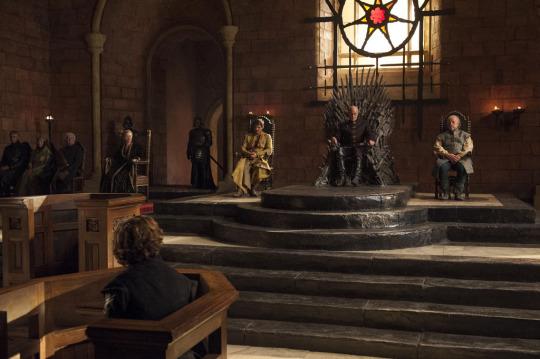
It’s the same when you go to Daenerys Targaryen’s chamber in Meereen, where she metes out justice to the various former slaves whose kids her dragons have just toasted. The set is just across the way in the original Paint Hall soundstage, so named because it was where they used to paint ocean liners. “We like to think of it as Morocco meets Frank Lloyd Wright,” says Head of Construction Tom Martin. It took 140 local workers 15 weeks to build and, like all of the Game of Thrones sets in Northern Ireland, stays up all year round, waiting for Thrones’ 300 strong shooting crew to return. Every one of the vast permanent Thrones sets has that same latent bravado about it — why would we fake it when we can just build it?
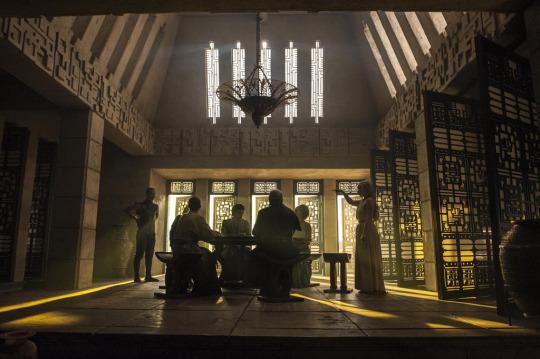
The only question that hangs over the creation of fantasy on such a grand scale is how can the biggest show on TV get any bigger? There must be, surely, a limit to the money HBO have available to spend — currently around the $100 million a season mark — yet the ambition of Game of Thrones’ creators David Benioff and Dan Weiss is vaulting. The Battle of Castle Black, a roiling donnybrook that took up most of last year’s ninth episode and featured woolly mammoths, angry giants and a vast swinging scythe (which we spotted in repose on the top of the Wall set — even in latex it’s fearsome) was a near hour of shock and awe, as relentless and formidable a piece of screencraft as you could wish for.
Yet suggest to Kit Harington that a peak may have been reached, and he’ll stop you short: “There’s a sequence this season which was bigger in scale than the entirety of episode nine last year and yet will take only 20 minutes of an episode The CGI and the number of background artists we had, the set, the money they spent on the set — it was bigger in scale. That sequence, if done right, which I have complete faith they will, should be quite astonishing. It should be a bit of a f–k me moment.” He pauses, as if the answer to our question is the most obvious thing in the world.
“Season Five will top Season Four.”
Game of Thrones premieres Sunday, April 12 at 9 p.m. on HBO


